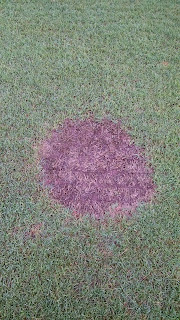Spring dead spot is a disease of warm-season turf grasses,
especially Bermuda grass. It is a disease that cannot be entirely prevented or
cured, only managed. Over the last couple of years we have made progress in the
management of the disease and we will continue to learn more each year.
You can read more about the specifics of the Spring Dead
Spot disease here
or read about the organic
compost program we have undertaken the last 2 years to help combat the
disease.
 |
| Notice the green grass in the center |
 |
| Green grass in center again |
This year was another different spring from the last 2, so
the Bermuda grass reacted in another different way. Our first green tissue in
the fairways was spotted March 8th, a full 3 weeks ahead of last
year. By all indications we were off and running, well ahead of last year’s
pace. But Mother Nature applied the brakes in early April. Within the first 10
days of April we had 3 nights that dropped below 25 degrees! That is not
Bermuda grass weather. All of the green tissue that had started to emerge was
shut down immediately. The Bermuda grass went back to its dormant brown color.
By the middle of April temperatures returned to normal and the Bermuda grass
essentially started over. What we noticed was that any tissue that never turned
green was healthier after the cold than the tissue that had greened up.
Finally, once the Bermuda was growing, we were able to start to take stock of
our spring dead spot infestation.
 |
| Notice no turf in center |
 |
| Absence of turf in the center |
We are pleased with the continued progress we have been making
against the disease. There are fewer incidences overall, as well as fewer
completely dead areas amongst the diseased locations. Similar to the evaluation
regarding our seed
head control program that was discussed last week, we also ran a test
regarding our chemical control of spring dead spot. Last winter, we purposely
skipped one trouble area with our chemical control. Instead, we only applied
the organic material to make sure that we were investing wisely in the chemical
applications. So far this spring we have seen that the chemicals are indeed
helping to lessen the severity of the disease. Looking at the pictures, in
areas that received both compost and chemical treatments, there is far more
healthy tissue within the disease circle. The area that only received compost
has no grass inside the circle. So it is apparent that the combination of compost and chemical treatments is improving our control and healing.
A second indication that we are holding our own against
spring dead spot is depicted in the pictures we have taken dating back to 2014.
On April 19th 2014, April 19th 2015, and now April 19th
2016 we have taken a picture from virtually the exact same location. What you
can see in the three pictures is the progress of the Bermuda grass each year in
comparison to the last. First, not every aspect of the Bermuda grass health is
due to our inputs. Weather plays the greatest roll. Warmer temperatures one
year can lead to more green grass, and the Bermuda in the picture from 2016 has
a yellow-green color to it, which is the result of the cold snap. However,
looking closer at the spring dead spot disease circles, one can see that there
are fewer and they are less severe each year that passes.
 |
| 4/19/2015 |
 |
| 4/19/2014 |
 |
| 4/19/2016 |
Spring dead spot is a disease that we must slowly work
against. It will never completely disappear, but we can continue to weaken the
pathogen through our control program. We have made strides in the last two
years and we will continue to adjust and improve our strategy.
Etiquette Reminder of the Month
When you splash bunker sand onto the green after your shot,
please brush away any large piles or clumps that may have ended up on the
green.
See you on the course!
Joe
jvillegas@bwrc.org

No comments:
Post a Comment
Have a question or comment? Share it with Joe!